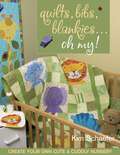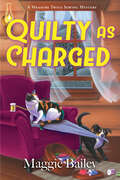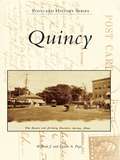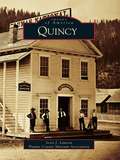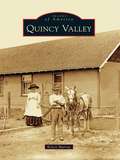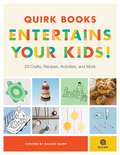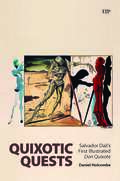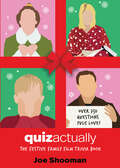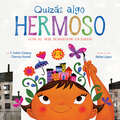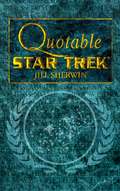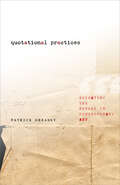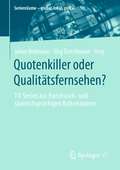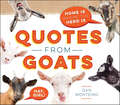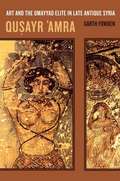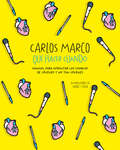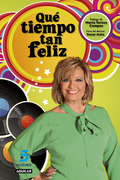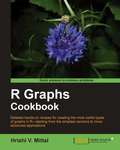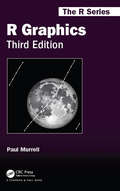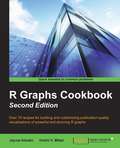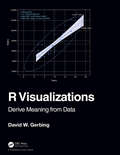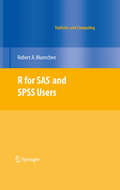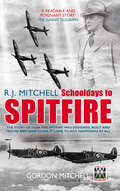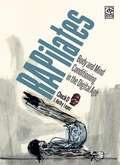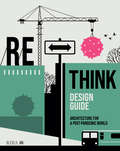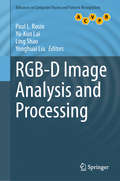- Table View
- List View
Quilts, Bibs, Blankies... Oh My!: Create Your Own Cute & Cuddly Nursery
by Kim SchaeferMake a Special Child Something Soft and Snuggly • 6 adorable collections of nursery accessories for babies and small children • Each collection includes a crib/bed quilt, plus a complete set of matching accessories • Colors and themes good for both boys and girls: sea creatures, jungle animals, trucks and trains, bugs and butterflies, and more • Beginner to intermediate projects are great to make for baby showers and charity events These lovable collections of nursery accessories have everything you need to give charm to a child's room: a crib quilt large enough for toddlers, too, plus wall quilts, bibs, drag-around blankets, soft pictures, pillows, and growth charts. Make that special child a whole room full of love.
Quilty as Charged (A Measure Twice Sewing Mystery #2)
by Maggie BaileyLydia Barnes has to thread the needle in order to discover the killer locked in with her amidst a sewing retreat in this second installment of the series, perfect for fans of Amanda Flower and Molly MacRae.Lydia Barnes has made the picturesque town of Peridot, Georgia her home. But as the new owner of the Measure Twice fabric store, all financial burdens fall on her. In an effort to unspool herself from this tangle of thread and boost the store&’s income, she invites her regular customers to a sewing retreat at her friend Fran&’s Cherry Log mountain home. In between sewing lessons and quick lunches, a severe winter storm approaches. When Fran&’s body is discovered murder is the only explanation, and the remaining six attendants are all suspects. Trapped, with the power and phone lines out, Lydia is restless to unmask Fran&’s murderer. With the help of Auden, the cabin&’s caretaker, Lydia must unravel the hidden lives of people she considered close neighbors and even friends, especially when another body is found along with a suicide note and a suspicious confession. In a daring plan to uncover the killer, Lydia must risk it all, including her life, before she is cut asunder and the bobbin runs out.
Quincy
by Elaine A. Pepe William J. PepeQuincy is known as the "City of Presidents" and the "Granite City." It is also known for its waterfront and the Fore River Shipyard. The city produced a president of the Continental Congress and two presidents of the United States. Quincy's granite was used to build the Bunker Hill Monument, Minot Lighthouse, and other cherished buildings around the country. The city's waterfront meanders for 27 miles, and its Fore River Shipyard is famous for manufacturing World War I and II warships. Residents proudly refer to Quincy as home. Quincy explores the many facets of Quincy life as they were uniquely expressed in an early-20th-century phenomenon: the postcard.
Quincy
by Scott J. Lawson Plumas County Museum AssociationSituated among the forests and lakes of northeastern California where the Sierra Nevada and Cascade mountain ranges meet, the town of Quincy is both picturesque and steeped in local history-from the Maidu Native Americans who first lived in the American Valley now called Quincy to the flood of people who came in the mid-1800s searching for gold. Quincy was born when Hugh J. Bradley, who helped organized Plumas County in 1854, laid out the town and named it after his home city in Illinois. Now the county's seat of government, Quincy boasts many attractive downtown buildings that have become the focus of the community's historic preservation and restoration efforts.
Quincy Valley (Images of America)
by Karen MurrayThe Quincy Valley is a unique place with a distinct environment. In the beginning, not even the local Columbia River tribes could find a use for the sagebrush desert, home to jackrabbits, coyotes, and rattlesnakes, but by 1910, immigrants from more than 20 nations called it home. Today the technology of the 21st century knocks on its door. From the early days of dry-land farming, to the abundant orchards and crops nourished by the Grand Coulee Dam, to the data-server farms of major Internet companies, the Quincy Valley provides food and information to the entire world. It is a community of people whose faith, families, and farms have provided physical sustenance and prosperity to its descendants. Their influence extends far and wide as they have spread across the world, serving in both military and civilian careers.
Quirk Books Entertains Your Kids: 20 Crafts, Recipes, Activities, and More!
by Raising QuirkThis summer, Raising Quirk&’s mission is to keep your kids from ever having to say &“I&’m bored.&” So we&’ve rounded up our favorite crafts, recipes, games, and activities from Quirk Books titles and jam-packed them into our funnest, awesomest, and kid-friendliest e-sampler yet. Whether you&’re taking your family on the road or stuck indoors on a rainy day, we&’ve got you covered. Projects include: COOKING: How to Teach a Kid to Cook Robot Bites Banana Split Pops Little-Bitty Fudge Puppies CRAFTING: Bottle-Cap FramesStarburst Straws Turtle Magnet Get Your Kid to Clean Up OUTDOOR ADVENTURE: Get Your Kid to Put On Sunscreen Plan a Scavenger Hunt Yakima! Choreograph a Fight Scene Nick and Tesla&’s Low-Tech (Practically No-Tech) Bottle Rocket and Launcher RAINY DAY ANTICS: Get Your Kid to Play Alone Futaleufú Mattress Rafting Put on a Comedy Show Learn a Magic Trick FUN ON THE GO: How to Keep a Family Happy During Car Trips Make Trail Mix and Hit the Trails! How to Build a Sand Castle Games to Play in the Car Children don&’t come with an owner&’s manual, so Raising Quirk brings together advice, activities, entertainment, and, most important, other parents who still feel kinda like kids themselves. Our motto: We help cool parents raise cool kids. After all, parenting is a lifelong adventure, and we&’re all in it together. Consider us your virtual playgroup and join us at Raising Quirk online.
Quixotic Quests: Salvador Dalí’s First Illustrated <em>Don Quixote</em> (Toronto Iberic)
by Daniel HolcombeSalvador Dalí illustrated Miguel de Cervantes’s Don Quixote for the first time while living in exile in the United States in the 1940s, collaborating with Random House to produce a special edition that was published in 1946. Quixotic Quests examines the material history of this 1946 edition by bridging art history, book history, literature, and narratology, while exploring Dalí’s role as its illustrator and the reception of both by mid-century popular culture, art historians, and literary scholars. Positing that much of Dalí’s life was quixotic in nature, the book investigates his quest to illustrate the novel with an unprecedented level of pictorial didacticism, despite challenges that the artist and Random House faced during and after the Second World War. It details his resolute passion to integrate surrealism with classicism, visual art with narrative, sexuality with sublimation, and privacy with public persona. Contrasting Dalí’s visual achievements with other artists and stylistic movements, Quixotic Quests sheds new light on the niche that Dalí created for himself as a surrealist illustrator of Don Quixote. Consulting his autobiographical narratives, the book analyses Dalí’s unique artistic contributions to the four-hundred-year print history of the novel, while emphasizing the artist’s heartfelt appreciation and respect for his book illustrations.
Quiz Actually: The Festive Family Trivia Book
by Joe ShoomanWith this entertaining quiz book, you can test your knowledge of beloved Christmas movies from Elf and The Grinch to Love, Actually and even Die Hard! If Christmas movies hold a special place in your heart—and your favorite scenes, lines, and trivia facts hold a special place in your memory—you&’ll love this festive family film trivia book. From rating the best (and worst) examples of the genre, to what even makes a &“Christmas movie&”, Quiz Actually is sure to spark lively debate around the holiday dinner table. Packed full of fun and tricky trivia questions, Quiz Actually will test your knowledge of the movies we watch every holiday season—from old time favorites like It&’s a Wonderful Life and Miracle on 34th Street to modern classics like Scrooged, The Nightmare Before Christmas, and many more.
Quizás algo hermoso: Cómo el arte transformó un barrio
by F. Isabel Campoy Rafael López Theresa Howell¿De qué sirve un toque de color en una comunidad de gris? ¡Como descubren Mira y sus vecinos, más de lo que puedas imaginar! Basado en la historia real del Urban Art Trail en San Diego, California, Maybe Something Beautiful revela cómo el arte puede inspirar la transformación, y cómo incluso los artistas más pequeños pueden lograr algo grande. ¡Toma un pincel y únete a la celebración!
Quotable Star Trek (Star Trek)
by Jill SherwinOrganised into categories such as friendship, diplomacy and management, Quotable Star Trek demonstrates the truly universal appeal of Gene Roddenberry's extraordinary creation. Words of wit, wisdom and compelling insight applicable to everyday life have been selected from over 500 hours of television episodes and eight Star Trek motion pictures. For more than thirty years the Star Trek universe has used its much-loved characters and consistently literate scripts to argue thought-provoking ideas, to tackle moral dilemmas, to deal with issues of humanity and responsibility, or to come up with intriguing solutions to seemingly intractable problems. Quotable Star Trek selects over 300 pages of gems which together encapsulate that unique and inimitable spirit.
Quotational Practices: Repeating the Future in Contemporary Art
by Patrick GreaneyLiterature and art have always depended on imitation, and in the past few decades quotation and appropriation have become dominant aesthetic practices. But critical methods have not kept pace with this development. Patrick Greaney reopens the debate about quotation and appropriation, shifting away from naïve claims about the death of the author. In interpretations of art and literature from the 1960s to the present, Quotational Practices shows how artists and writers use quotation not to undermine authorship and originality, but to answer questions at the heart of twentieth-century philosophies of history.Greaney argues that quotation is a technique employed by art and philosophy to build ties to the past and to possible futures. By exploring quotation&’s links to gender, identity, and history, he offers new approaches to works by some of the most influential modern and contemporary artists, writers, and philosophers, including Walter Benjamin, Guy Debord, Michel Foucault, Marcel Broodthaers, Glenn Ligon, Sharon Hayes, and Vanessa Place.Ultimately, Quotational Practices reveals innovative perspectives on canonical philosophical texts as well as art and literature in a wide range of genres and mediums—from concrete poetry and the artist&’s book to performance, painting, and video art.
Quotenkiller oder Qualitätsfernsehen?: TV-Serien aus französisch- und spanischsprachigen Kulturräumen (Serienräume – global, lokal, glokal)
by Julien Bobineau Jörg TürschmannDer bisherige Fokus der TV-Serienforschung auf US-amerikanische Produktionen hat gemeinsam mit dem steten Aufstieg innovativer Serienformate aus der Romania zu einer großen Forschungslücke geführt. Der Sammelband versucht diese Leerstellen durch ausgewählte Überblicksbeiträge und Fallstudien zu schließen und zu weiterführenden Forschungen innerhalb der Literatur-, Kultur-, Medien- und Filmwissenschaften anzuregen.
Quotes from Goats
by Dan MonteiroInspirational quotes and photos of adorable goatsGoats are the animal du jour – “goat yoga” (yoga with baby goats) has exploded in popularity, and social media is flooded with photos of cute kids. Quotes from Goats pairs irresistible photographs of everyone's favorite barnyard animal with inspiring quotations that resonate with both goats and humans, like:“The best view comes after the hardest climb.”"Never skip family dinner time!""Take a walk on the wild side."
Qusayr 'Amra: Art and the Umayyad Elite in Late Antique Syria
by Garth FowdenQusayr'Amra is a major Islamic archaeological site, a princely bathhouse with intact frescoes dating from the mid-eighth century. Fowden offers and imaginative and compelling analysis of the iconography and artistic context of the paintings and addresses fascinating and topical questions about early Islamic culture and the West.
Qué hacer cuando: Manual para afrontar los cambios de jóvenes y no tan jóvenes
by Carlos MarcoUna visión personal e íntima sobre la vida, de la mano de Carlos Marco. Un manual para perseguir tus sueños y lograr el éxito personal. ¿Qué hacer cuando... ...te sientes atrapado? ...quieres gustarte por dentro y por fuera? ...necesitas un cambio en tu vida? ...no sabes si eres feliz? La filosofía del cantante Carlos Marco se resume en este manual vital. Un joven con las mismas preocupaciones que tú: el futuro profesional, la soledad, la timidez, el miedo a no encajar... Preocupaciones de cualquiera, compartidas en este libro lleno de consejos prácticos desde su propia experiencia. «Nada es definitivo. Casi nada de lo que hagas condicionará para siempre tu vida. El mundo se mueve, la vida gira, y tú con ella, y lo que ahora ves como algo que jamás podrá cambiar en realidad no es así. Quizás en unos meses, en unos años, o tal vez de un día para otro, puedas levantarte y querrás cambiar el rumbo.»Carlos Marco
Qué tiempo tan feliz
by María Teresa Campos LuqueQué tiempo tan feliz nos transporta de manera mágica a un pasado que sigue muy presente en nuestras vidas. Las luces y las sombras de artistas, películas, espacios televisivos y canciones que forman parte de la cultura popular de España. ¿Sabías que los «Quince años» del Dúo Dinámico hizo que más de un padre se llevara las manos a la cabeza en los sesenta?, ¿que Los Pecos tuvieron que hacer la mili para dar ejemplo y que Manolo Escobar era conocido no sólo por sus canciones, sino por su forma de besar en el cine? ¿Sabías que María Jiménez fregaba los suelos de las casas en las que le dejaban cantar, que Fórmula V tuvo problemas con la censura, que Arévalo empezó como Bombero torero o que Bustamante es un maniático del orden? Qué tiempo tan feliz reúne para ti los mejores momentos, los más entrañables, divertidos, curiosos, vividos en directo junto a María Teresa Campos, el director del programa, Yusan Acha, el equipo y los invitados, y da cuenta de anécdotas sorprendentes que se revelaron en este espacio por primera vez. Gracias a un estilo ameno rebosante de guiños a un lugar común que nos acerca a pesar de la edad y de las experiencias vividas, Qué tiempo tan feliz nos transporta de manera mágica a un pasado que sigue muy presente en nuestras vidas. Las luces y las sombras de artistas, películas, espacios televisivos y canciones que forman parte de la cultura popular de España y que componen un fresco en el que el ayer y el hoy conviven con naturalidad. La memoria de una época que evoca recuerdos agradables, un tiempo tan feliz. «Este libro bucea en los recuerdos, en la sentimentalidad de los momentos y de las personas que pertenecen a nuestras vidas, en las luces y las sombras de las trayectorias de éxito mientras se acerca al presente, a las generaciones que crecieron con ellos y a las nuevas que tienen interés en descubrir nuestra historia más reciente».María Teresa Campos
R Graph Cookbook
by Hrishi V. MittalThis hands-on guide cuts short the preamble and gets straight to the point - actually creating graphs, instead of just theoretical learning. Each recipe is specifically tailored to fulfill your appetite for visually representing you data in the best way possible. This book is for readers already familiar with the basics of R who want to learn the best techniques and code to create graphics in R in the best way possible. It will also serve as an invaluable reference book for expert R users.
R Graphics, Third Edition (Chapman & Hall/CRC The R Series)
by Paul MurrellThis third edition of Paul Murrell’s classic book on using R for graphics represents a major update, with a complete overhaul in focus and scope. It focuses primarily on the two core graphics packages in R - graphics and grid - and has a new section on integrating graphics. This section includes three new chapters: importing external images in to R; integrating the graphics and grid systems; and advanced SVG graphics.The emphasis in this third edition is on having the ability to produce detailed and customised graphics in a wide variety of formats, on being able to share and reuse those graphics, and on being able to integrate graphics from multiple systems.This book is aimed at all levels of R users. For people who are new to R, this book provides an overview of the graphics facilities, which is useful for understanding what to expect from R's graphics functions and how to modify or add to the output they produce. For intermediate-level R users, this book provides all of the information necessary to perform sophisticated customizations of plots produced in R. For advanced R users, this book contains vital information for producing coherent, reusable, and extensible graphics functions.
R Graphs Cookbook Second Edition
by Jaynal Abedin Hrishi V. MittalTargeted at those with an existing familiarity with R programming, this practical guide will appeal directly to programmers interested in learning effective data visualization techniques with R and a wide-range of its associated libraries.
R Visualizations: Derive Meaning from Data
by David GerbingR Visualizations: Derive Meaning from Data focuses on one of the two major topics of data analytics: data visualization, a.k.a., computer graphics. In the book, major R systems for visualization are discussed, organized by topic and not by system. Anyone doing data analysis will be shown how to use R to generate any of the basic visualizations with the R visualization systems. Further, this book introduces the author’s lessR system, which always can accomplish a visualization with less coding than the use of other systems, sometimes dramatically so, and also provides accompanying statistical analyses. Key Features Presents thorough coverage of the leading R visualization system, ggplot2. Gives specific guidance on using base R graphics to attain visualizations of the same quality as those provided by ggplot2. Shows how to create a wide range of data visualizations: distributions of categorical and continuous variables, many types of scatterplots including with a third variable, time series, and maps. Inclusion of the various approaches to R graphics organized by topic instead of by system. Presents the recent work on interactive visualization in R. David W. Gerbing received his PhD from Michigan State University in 1979 in quantitative analysis, and currently is a professor of quantitative analysis in the School of Business at Portland State University. He has published extensively in the social and behavioral sciences with a focus on quantitative methods. His lessR package has been in development since 2009.
R for SAS and SPSS Users
by Robert A. MuenchenThis book introduces R using SAS and SPSS terms. It demonstrates which of the add-on packages are most like SAS and SPSS and compares them to R's built-in functions. It compares and contrasts the differing approaches of all three packages.
R.J. Mitchell: The Story of How the Spitfire Was Designed, Built and Tested and How Close it Came to Not Happening at All
by Gordon MitchellThe Spitfire began as a near disaster. The developments of this famous aircraft took it from uncompromising beginnings to become the legendary last memorial to a great man - and elegant and, with its pilots, a highly effective, weapon of war. The Spitfire would not have happened at all, however, without Mitchell's indomitable courage and determination in the face of severe physical and psychological adversity resulting from cancer. His contribution to the Battle of Britain, and thereafter to the achievement of final victory in 1945, was so great that our debt to him can never be repaid. This poignant story is written from a uniquely personal viewpoint by his son, Gordon Mitchell.
RAPilates: Body And Mind Conditioning In The Digital Age
by Chuck D Kathy LopezHip-hop icon Chuck D presents a gorgeously illustrated Pilates exercise program for people of all ages, including the over-forty crowd LEGENDARY HIP-HOP ARTIST CHUCK D has been touring the world for four decades, since his band Public Enemy put out their first album in 1987. Now, at age sixty-three, Chuck is frequently asked how he still manages to put on such high-energy performances so many years later. His response is simple: he practices Pilates, a form of exercise and body conditioning that has become increasingly popular over the last decade. Chuck’s appreciation for Pilates took a major leap in 2016 when he was setting out on a rigorous tour schedule with a powerful and energetic new band called Prophets of Rage (a supergroup including members of Public Enemy and Rage Against the Machine). Over the next four years, the group would perform to more than two million people across the globe. As Chuck admits, he simply could not have delivered on such a massive level without his practice of Pilates. In this volume, Chuck and his Pilates guru, Kathy Lopez, present the “RAPilates” program of more than thirty mat-based exercises for people of all ages and experiences. The exercises are beautifully illustrated in the inimitable style that Chuck has demonstrated in his previous books of visual art, including STEWdio and Summer of Hamn. Like those two books, RAPilates is published on Chuck’s Enemy Books imprint, which is hosted by Akashic Books.
RETHINK Design Guide: Architecture for a post-pandemic world
by Nicola Gillen; Pippa Nissen; Julia Park; Adam Scott; Sumita Singha; Helen Taylor; Ian Taylor and Sarah FeatherstoneThe world has changed. How will society emerge post-pandemic? Will we take the opportunity to reset the status quo? And, if so, what possibilities are there for architects to take the initiative in designing this new world? This innovative design guide draws together expert guidance on designing in the immediate aftermath of the pandemic for key architectural sectors: housing, workplace, civic and cultural, hospitality, education, infrastructure and civic placemaking. It provides design inspiration to architects on how they can respond to the challenges and opportunities of a post-pandemic environment and how architects ensure they are at the forefront of the best design in this new world. Looking at each sector in turn, it covers the challenges specific to each, and how delivering these designs might differ from the pre-pandemic world. As well as post-pandemic design, the vital issue of climate change will be threaded through each sector, with many cross-overs between designing for the climate emergency and designing for a world after a pandemic. Both seek to make the world a safer, happier and more resilient place. Written by set of contributing design experts, this book is for all architects, whether sole practitioners or working in a larger practice. As well as inspirational design guidance, it also provides client perspectives – crucial for understanding how clients are planning for the future too.
RGB-D Image Analysis and Processing (Advances in Computer Vision and Pattern Recognition)
by Yonghuai Liu Ling Shao Paul L. Rosin Yu-Kun LaiThis book focuses on the fundamentals and recent advances in RGB-D imaging as well as covering a range of RGB-D applications. The topics covered include: data acquisition, data quality assessment, filling holes, 3D reconstruction, SLAM, multiple depth camera systems, segmentation, object detection, salience detection, pose estimation, geometric modelling, fall detection, autonomous driving, motor rehabilitation therapy, people counting and cognitive service robots. The availability of cheap RGB-D sensors has led to an explosion over the last five years in the capture and application of colour plus depth data. The addition of depth data to regular RGB images vastly increases the range of applications, and has resulted in a demand for robust and real-time processing of RGB-D data. There remain many technical challenges, and RGB-D image processing is an ongoing research area. This book covers the full state of the art, and consists of a series of chapters by internationally renowned experts in the field. Each chapter is written so as to provide a detailed overview of that topic. RGB-D Image Analysis and Processing will enable both students and professional developers alike to quickly get up to speed with contemporary techniques, and apply RGB-D imaging in their own projects.
